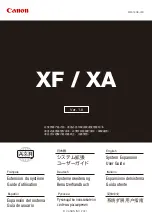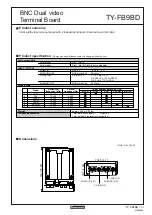
User Information Guide – Protective Helmets for Structural Firefighting
warrant its disposal.
•
Replacement After Impact or High
Heat Exposure:
Your helmet is made
to absorb the energy of a blow by
partial destruction or damage to the
shell and/or suspension system. Even
though such damage may not be
readily apparent, you should replace
your helmet if it is subjected to a
severe impact or excessive heat.
•
Warranty:
This helmet is NOT
warranted to be fit for a particular
purpose. Read carefully the “Warranty
Information” in this guide. If labels in
the helmet are missing or become
unreadable, contact Honeywell for
replacement label information.
Marking Recommendations
– Do not
attempt to alter or modify your helmet.
Do not paint or apply any materials to
the exterior of the helmet that have not
been approved by Honeywell. For
identification purposes, you may mark
your protective helmet on the interior
using an indelible marker, if permitted by
your department or organization. Do not
write over or obscure information on the
product label.
Testing and Assessment of
Performance
– Your protective helmet
has been evaluated for a number of
performance properties that are based
on the respective standard(s) for its
certification. These properties include,
but are not limited to, impact resistance
and force acceleration, physical
penetration resistance, heat and thermal
shrinkage resistance, flame resistance,
electrical insulation, retention system
slippage, suspension system retention
(on the head), shell separation, label
durability and legibility, corrosion
resistance, and trim visibility. For an
understanding of the performance
requirements and test methods, review
the NFPA 1971 standard and the
Honeywell Reference Guide.
None of the NFPA 1971 performance
properties can be evaluated in the
field. If you have questions, check with
your department or organization, who
in turn can contact Honeywell.
Preparation for Use
Adjusting Proper Fit
– The integrity, fit,
and proper assembly of the helmet, sus-
pension, and chinstrap must be
checked before each use. Your safety
depends upon the proper fit of your
helmet and proper use of all features
and components. Typically, helmets are
adjusted so that the helmet is tilted
approximately 5 degrees above a level
horizontal plane to properly
accommodate your SCBA facepiece.
This adjustment is referred to as a
“helmet positioning index (HPI)” for
purposes of helmet testing and
certification.
All adjustments are independent of how
far your head goes into the helmet and
DO NOT affect the length of the
overhead suspension straps.
Adjusting the Headband
1. Three large
white hook
and loop
tabs secure
headband
into liner.
These tabs
are located
on the front and on both sides.
The hook parts of the hook and
loop are fixed into the helmet in
the same positions.
2. Adjust the position of the tabs up
and down vertically inside the
liner.
3. The lower edge of the headband
should rest near the top of your
ears. This will ensure the best
lateral stability of the helmet.
Adjusting
Your Helmet
to Fit Your
Head
Rotate the
ratchet control
knob to
expand or
contract the
band to provide comfortable but firm fit.
Securing the Chinstrap
Check the operation of the chinstrap
buckle before putting the helmet on
your head. When the buckle is closed,
both push levers on the female side
(mating clip) must be depressed
before the male side (prong) will with
draw.
Step 1
–
Insert the
prong into
the mating
clip until it
snaps in with
a clicking
sound.
Step 2
– Pull the free end at the post-
man buckle to tighten the strap. Attach
the free end to the hook and loop to
stow it.
Always keep your chinstrap securely
fastened during firefighting operations.
Operating the EZ Touch Eye Protector
Deploying
1. Use your
thumb to
gently push
the lower
edge of the
eye
protector
upward.
2. A clicking sound will be heard and
the eye protector will automatically
descend gradually from the stowed
position.
Stowing
1. Use your
thumb to
gently push
the eye
protector back
up.
2. Stop pushing when you hear the
clicking sound. The eye protector is
now in the stowed position.
Storage
When not in use, the EZ Touch eye
protector should be stored using the
safety latch.
Locked
position:
Safety latch
extended out
over the edge
of the
eye protector.
Unlocked
position:
The
safety latch
rotates away
toward the
inside of the
helmet.
Adjustment of Eye Protector Height
To adjust the
eye protector
height for a
comfortable
fit, use the
hex key pro-
vided. Turn
the pictured
small hex screw (on the left underside
of the helmet brim) to adjust the
resting position of the eye protector on
the bridge of your nose.


























